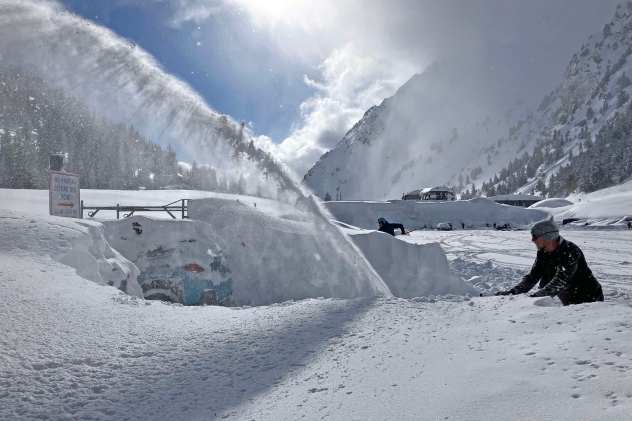880 inches of snow helps pull Utah out of short-term drought
One of 2023's most significant weather developments has been the rapid improvement of drought conditions in the West, with more than half of California's population finally getting out of brutal long-term drought. The same storms that have caused such a dramatic turnaround in California have also significantly improved the drought situation in Utah, as the state has climbed out of extreme drought for the first time in nearly three years, thanks to record snowfall.
AccuWeather Senior Meteorologist Alan Reppert says snowfall in some Utah mountains was "well over record levels" this season.
One of Utah's premier ski areas, Alta, recorded a stunning 879.5 inches of snowfall -- over 73 feet -- through early April, breaking the 43-year seasonal record of 748 inches from the 1981-82 season. That number is also nearly double the 445.5 inches of accumulation in the 2021-2022 snow season.
Another nearby resort, Brighton, recorded 850 inches of snowfall, more than double the 406 inches recorded in the 2021-2022 snow season.
 |
Employees work to locate and extract their vehicles following a 66.5-inch storm at Alta Ski Area in Utah on April 5, 2023 |
Removing that much snow isn't easy, and avalanche dangers or closed roads caused Alta to invoke "interlodge" conditions -- requiring people to stay inside -- many times this winter.
Jonathan Morgan of the Alta Avalanche Office said in a blog post, "We try and run a ski area every day of the season, but in a place like this, there are a few days of the season where you have to give in and let the storm do its thing."
Park City Mountain announced Wednesday that it would extend its ski season longer than usual. The new closing date for the resort -weather and conditions permitting - is May 1. Snowstorms that lasted into early April at the resort delivered more than 610 inches of snowfall, breaking the resort's seasonal record.
"After snowstorms that lasted into early April, delivering more than 610 inches and breaking every snowfall record on the books, we are finally enjoying spring skiing on a base depth of 142 inches," the resort said in a Facebook post.
Alta's last skiing day will be April 23, mainly due to increased avalanche danger.
Reppert pointed to the storms that brought much-needed rainfall to the West Coast as a major boost for Utah's drought problem.
"The storm track into California and through the central and southern Rockies has helped bring the storms through the region this year," he explained, adding that more storms affected Utah than the last few years.
Earlier in April, Utah officially broke its record for snowpack levels when the snow water equivalent hit 29 inches, according to KUTV. The previous record of 26 inches was established in 1983. This has helped bring moisture back to the area along with well-above-historical-average rainfall. Utah Snow Survey Supervisor Jordan Clayton told 2News that every basin in Utah had recorded at least 160% of normal snowpack, with many major basins exceeding 200%.
"Though there is still some drought over much of the state, the snowpack melting through will aid the recovery from the drought," Reppert said.
According to the United States Drought Monitor, none of Utah's population is under the worst two drought stages, extreme and exceptional drought, as of April 13. Utah had been experiencing at least extreme drought since June 2020, and as of the start of the 2022-2023 water year in September, just over 56% of the state was in an extreme drought.
 |
This Nov. 23, 2013, file photo, shows skiers at Park City Mountain Resort, in Park City, Utah. |
At the start of the 2022-2023 water year, all of Utah was under at least moderate drought conditions, which decreased to just over 40% in April. An even more stark decrease occurred around severe drought conditions. More than 95% of Utah was under severe drought in September 2022, a number that plunged to just under 9% in April.
Although the drought reduction is welcome news for the state, it won't solve all of its problems. After sounding the alarm last fall that Utah's Great Salt Lake might disappear in five years, scientists say this winter's record snowpack may slightly extend the lake's life but won't save it from disappearing entirely.
Another potential issue from the impressive snowpack totals are flood risks from significant runoff. On Tuesday, Utah Gov. Spencer J. Cox declared a state of emergency to assist with response and relief to natural disasters in the coming months. Along with flooding, Cox noted that avalanches and landslides were of concern.
Correction: This story previously misstated the name of Utah's governor. The current governor is Spencer J. Cox, not Mike Lee, who is a U.S. senator from Utah.
Want next-level safety, ad-free? Unlock advanced, hyperlocal severe weather alerts when you subscribe to Premium+ on the AccuWeather app. AccuWeather Alerts™ are prompted by our expert meteorologists who monitor and analyze dangerous weather risks 24/7 to keep you and your family safer.




